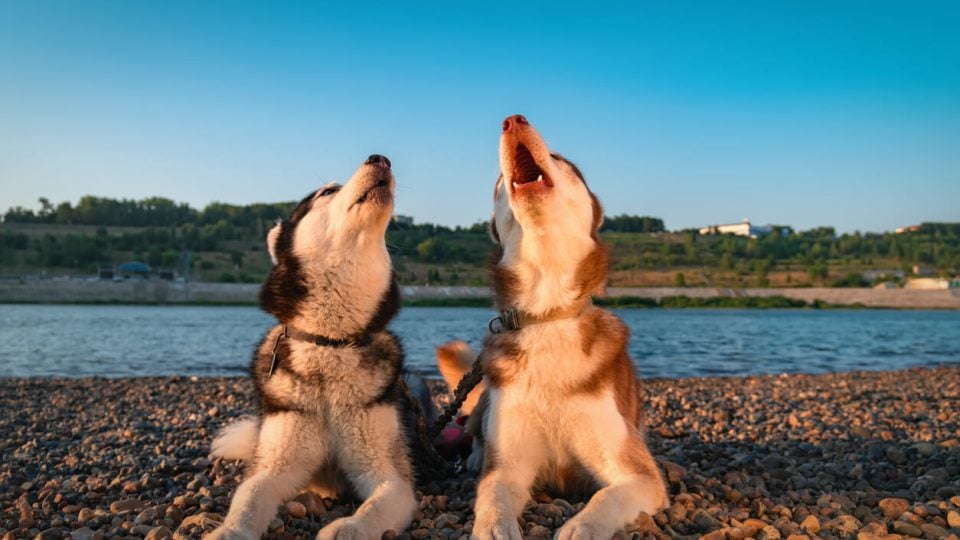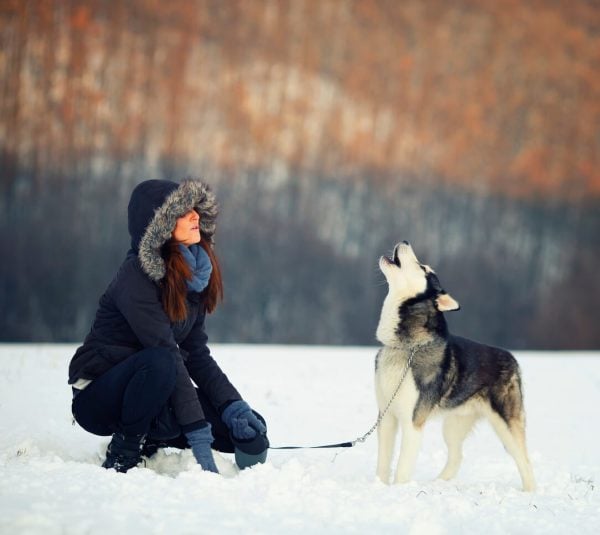- Not a substitute for professional veterinary help.
When it comes to the various sounds a dog might make, most people tend to think of barking. But if you’ve ever spent time around Siberian Huskies, the famous “Husky scream” may come to mind first.
This breed has a reputation for their varied vocalizations, which range from screams to “chatter.” Huskies make so many different sounds because of their genetics and breeding history, according to Tim Goolsby, husky breeder at Halo Huskies.
Screaming is rooted deep in Siberian Husky genetics, and they make this vocalization for many reasons, from excitement to frustration—something you might already know if you’ve ever witnessed a Husky tantrum!
Read on to discover what makes Huskies such vocal dogs and how to interpret the Husky scream!
Deciphering Husky Sounds
Alongside screams, Huskies make many other sounds. Goolsby shares some of the most common sounds and their meanings:
- Screaming: Anxiety, frustration, excitement, attention
- Howling: Communicating with other dogs and animals, seeking attention, responding to loud sounds like sirens, bonding
- Whining: Stress, desire for something, pain or discomfort
- Talking: Attention, engagement, expressing emotions
- Barking: Excitement, alerting, frustration (less common among Huskies)
- Growling: Playfulness, warning, fear, aggression
- Yipping and yowling: Playfulness, anticipation
- Moaning or sighing: Contentment, frustration
Each sound has its own meanings—but no matter what noise they’re making, their vocalizations are unique and interesting to listen to, Joe Swiffen says. Swiffen, the director at Mynydd Sleddog Adventures, has over 25 years’ experience keeping and training huskies
Reasons Why Huskies Scream & Howl
Your Husky isn’t screaming for no reason! Various factors might lead them to engage in this vocalization.
Boredom
“When dogs are bored, they may vocalize to ask for your attention,” says Lauren Sharkey, canine behaviorist at Winnie’s World.
While it can be tempting to try and ignore these cries for attention, this might make things worse. “Ignoring smaller requests for attention can lead to a dog escalating, with the sounds becoming more intense,” Sharkey adds.
Stress
Stress-related screams can involve both positive and negative emotions.
Positive stress can come up in the form of excitement, something frequently seen by Swiffen. “When our dogs know they’re going to work, this is when they are at their loudest. They howl and scream with excitement and anticipation.”
Meanwhile, negative stress screams might relate to fear, anxiety, or frustration. For instance, Huskies may start screaming if experiencing separation anxiety.
“Huskies are known to develop strong attachments to their families and they can become anxious when left alone,” Goolsby says, adding that they’re pack animals, which is why he recommends pet parents get more than one Husky.
Environmental changes
Huskies might also scream in response to changes in their environment.
“Changes in environment can increase dogs’ arousal levels, and we can often see them channel that arousal through breed-specific behaviors,” Sharkey says.
In the case of huskies, that behavior is screaming!
Trying to communicate
While Huskies can’t speak human language, they vocalize for many of the same reasons—including to share their needs or emotions.
“If any dog is vocalizing, they are trying to communicate how they are feeling or that they need something,” Sharkey explains.
Responding to loud noises
Some Huskies are known to “answer” loud sounds, such as a siren from an emergency vehicle, with screams or howls.
“We live in the country and they use their vocalizations to communicate with the coyotes around here,” Goolsby says. “We assume they’re letting the coyotes know this is not the place they want to come hunting.”
How Did Huskies Become So Vocal?
Husky vocalizations and behaviors mimic those of their wolf ancestors. Once people began to breed Siberian Huskies as working dogs, these wild traits lingered to support them in their work.
“They needed to communicate with their handlers and pack to coordinate and alert for dangers,” Goolsby explains. Their varied sound range enables them to achieve this goal clearly and efficiently, from communicating dangers to socializing in packs.
Ever hear a group of Huskies screaming together? Huskies have a strong sense of family and togetherness, and vocalizing is a way they can bond and communicate their needs, says Swiffen.
However, not all huskies are loud talkers. “Some are from birth and some aren’t. It’s kind of like a personality trait,” Goolsby says.
Can Huskies Talk?
Even though their vocalizations sound human, experts agree that Huskies—and other canines—can’t produce human speech. So what’s going on?
“Huskies appear to have a unique ability to produce complex, variable vocalizations that can mimic the tone and rhythm of human speech,” Swiffen says. “They may use long ‘wooo’ or ‘raaoo raaooo’ sounds, accompanied by changes in pitch, making it seem like they’re forming words or sentences.”
While canine vocal cords are similar to human vocal cords, they’re not exactly the same—which is one reason dogs can’t “talk” in the way we do.
Swiffen explains that these talk-like sounds often occur in response to human communication, further enforcing the illusion of conversation. However, this form of vocal mimicry is more about emotional expression than any attempt at true speech, she says.
“I’m not convinced that Huskies are imitating human speech intentionally, but their social intelligence allows them to pick up on human behaviors,” Swiffen says.
How To Communicate With Your Husky
Learning to understand and communicate with your Husky won’t happen overnight.
Think of it like talking to a toddler, Goolsby suggests. “It gets better the more you spend time with them and get to know them!”
Sharkey emphasizes that good communication is essential when it comes to training Huskies, as a strong bond provides an essential foundation. “They can be more difficult to train as they can be more independent than other dogs,” she says.
A few key approaches can aid in speeding up the communication process and better understanding what your dog is trying to tell you:
- Read their body language: “As well as taking the time to figure out what all their different sounds mean, look at the other parts of their body for clues,” Sharkey recommends.
- Consider the context: Goolsby recommends that pet parents pay attention to the context and what’s happening when your dog makes a specific sound.
- Be patient: With time, you’ll begin to recognize patterns in your dog’s vocal behavior, Swiffen says. “Certain sounds repeated in similar situations, like the same whine when they need to go out, will become more identifiable.”
- Listen deeper: “Pay attention to volume, frequency, and intensity to get insight into the urgency of your dog’s feelings,” Goolsby says.
From screams and growls to yips and barks, huskies have one of the most varied vocal ranges of any canine breed. This unique characteristic might seem tricky to decipher at first, especially for new pet parents.
But with a dose of patience and a splash of clue hunting, cracking that code will bring a sense of achievement and solidify the life-long relationship with your furry pal.




